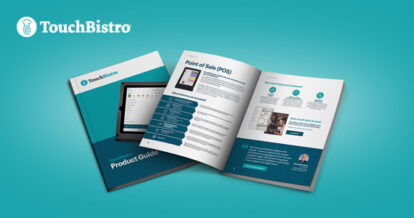Unless you’re under the age of 23, when you think of what is a POS system in a restaurant, you probably think of hulking computer stations that run at the pace of a sloth on sleeping pills. You might still be woken by the terror of a modifications error that snowballed into a customer complaint, a tip of zero percent and a permanent stain on your serving record. In your mind, POS systems might be synonymous with the emergence of a few grey hairs. But oh, how the tides of restaurant point of sales have changed.
The advent of the iPad has overhauled restaurant operations. Orders are taken table side, bills are split in seconds, and, now more than ever, restaurateur and managers have visibility into the business’s most pertinent data. With that information, they can schedule staff better, serve needs better, equip themselves faster than ever. With so much change in the last five years, we began to wonder: what’s next?
Enter Justin Guinn, market research expert at SoftwareAdvice.com. Guinn and Software Advice help business owners looking for POS software to choose a solution that addresses not just some of their pain points, but every single one. They’ve got their finger on the pulse of the latest innovations in the POS industry. What’s more? They know where it’s going. In order to better understand the future of restaurant POS technology, we sat down with Guinn to find out everything from yesterday’s innovations, to today’s trends, to tomorrow’s growth.
TouchBistro: Justin, you’re an expert in the restaurant POS space, having conversations with restaurant owners and POS vendors every day. What are some of the trends you’ve been seeing popping up in the space?
Justin Guinn: In the restaurant space, the trend towards mobile POS is very, very apparent. It’s definitely the biggest shift happening right now. The primary reason for this? There is an incredible operational benefit gained when servers can take orders and complete transactions anywhere in the restaurant, as opposed to having them go back and forth to terminals. The servers are more efficient, tables are turned over faster, there is no lag between order and order submission, and, of course, way less room for error.
TB: Is one style of dining outpacing another in terms of mobile POS adoption rates?
JG: Off hand, it makes sense for all of styles of dining to adopt. One interesting adoption phenomenon is the food truck boom, which is happening all throughout North America. Food trucks are popping up everywhere and they’re primarily powered by iPad POSs. Aside from that, it makes sense for cafés who have counter service to use iPad POSs due to limited, and valuable, counter space. Rather than having a cash register, a monitor and all the bells and whistles that come with a traditional legacy system, they save space with a compact POS.
TB: Why do you think more restaurant owners and operators are choosing an iPad POS solution, opposed to a traditional legacy POS system?
JG: They’re proven, they’re ubiquitous, and people have experience with them. From the consumer side, iPads are typically the first tablet customers and restaurant staff are exposed to. This makes the iPad an easy first choice. iPads are relatively affordable, they’re easily acquired and therefore scalable, and as far as payment options go, very rarely do you see payment apps that are offered exclusively on other platforms. They’re mainly available for iPad users.
TB: Are there any specific capabilities you’ve noticed customers are looking for?
JG: We have representatives that speak with business owners every day and identify their pain points. Then they recommend software that fits the business’s individual needs. Meanwhile, I analyze those conversations, and pull data points to better understand the market. Doing this, I discovered that, surprisingly, 63% of restaurants don’t have a restaurant POS system in place. Within that number, 73%, just under 3/4ths, are requesting mobile POS. The overwhelming majority are indicating iPad POS.
In terms of features, reporting and analytics is most sought after. Restaurant owners want more transparency into how individual servers are doing, how individual dishes are doing, what the best times of the day are for service, what the best days in general are for service. They desire that transparency because it gives you incredible insight that hasn’t always been available and there’s no way to get that information without the reporting and analytics feature.
Next, the ability to more effectively communicate with the kitchen is huge. Rather than writing a ticket and putting it in the window, with a mobile POS system, servers input the meal as the customer orders it, complete with modifications. They send it to the kitchen before they even leave the table. While this leads to a reduction in errors between servers and the kitchen, even servers, and the bar, it also leads to a reduction in errors in general. With traditional systems, you’ll always have a server that thinks they’ll remember the order, but by the time they get to the terminal, they might forget to add a modification to the order. If you’re putting it into the POS system at the table, you’ll never miss it.
Customer loyalty and customer management are also highly desired capabilities. Restaurateurs want to capture and store customer data, and then use that data in marketing to entice customers to come back to the restaurant via giveaways and promos etc. Whether it’s email addresses that are logged, or a loyalty card that’s issued, restaurants can collect more data and thus, market more effectively. POSs often integrate with these reward apps, so that let’s say, if someone earned a free dessert, it would be indicated on the POS app.
The ability for restaurants to manage their inventory is sought after. On the one hand, restaurant managers don’t want to run out of things during the middle of a dinner rush, but on the other hand, you don’t want to have Wagyu beef spoil; the cost of that loss would be huge. The ability to properly manage your inventory is something that a mobile POS can help with pretty easily.
TB: What’s been the biggest evolution you’ve seen in the POS industry?
JG: Going back to reporting and analytics, with legacy systems, you’re getting an older, spit-out, non-customizable report with minimal granularity or transparency. Now, you have POSs with easy to read, customizable dashboards that can pretty much gather and sort any information you need. They come complete with customizable charts, dashboards, and reports.
TB: What do you think are the main barriers for restaurateurs who haven’t adopted POS tech yet?
JG: We coined the term comfortable disorganization to describe why restaurateurs aren’t jumping into what very obviously seems to be the best way to manage their restaurant. The mentality behind this is, “if it’s not broke, don’t fix it.” Also, restaurant POS technology is a vast market, so it can seem intimidating. Given the nature of technology and its history, restaurateurs might think they’ll have to shell out a lot of money. This is not the case with all the cloud-based products out there now, which make it accessible and easy for restaurateurs to get a baseline POS in place.
TB: For a new restaurant owner that is evaluating POS systems, what would your 3 key pieces of advice be?
JG: I address this in an article I recently wrote called, 5 Tips to Avoid Botching Your POS Implementation. For my first piece of advice, I’d say to start by taking a step back. More than anything, you need to understand your pain points operationally and in your day-to-day. This includes the pain points of each of your staff members: your bartenders, your kitchen staff, your servers, and your managers – anyone who’s touching technology. Compile all of these pain points into a list. The system you choose should take care of all of these.
Second, I would absolutely recommend something mobile, specifically, a POS that uses the iPad. It’s ubiquitous, whether customers or your staff have to interact with it. It’s easy to use, easy to train on, inexpensive, and very reliable.
Third, make sure you train your employees on the best way to use that mobility and leverage the full range of capabilities your POS offers. Make sure your staff have the device on them all the time. This aids in your customer experience, and will even allow you to turn tables over faster, which means more revenue.
TB: What would you tell restaurant owners to absolutely avoid?
JG: Absolutely avoid choosing a POS because it’s the cheapest option or based solely on price. In the end, when it doesn’t meet your needs, you’ll end up paying more money for it. Invest in your POS. It is, after all, the backend that manages and logs everything in your restaurant.
TB: In the year 2020, what do you think POS technology will look like? What trends do you predict for restaurant tech in the future?
JG: We could speculate that POS technology could evolve into a device that consumers carry on them. Regardless of the device, POS technology will continue to evolve, get faster and continue to make the customer experience better. They’ll continue to increase operational benefits, make it easier to manage a restaurant and easier to monetize. Of course, they’ll make the restaurant experience more enjoyable, whether that’s streamlining the ordering process to the point where there’s a tablet at every table or a kiosk model, where you walk in and order and pay, and everything is brought out for you. While technology is evolving, I don’t think the experience of being served will ever go away completely.
Justin Guinn is a point-of-sale market researcher, focusing on navigating the complexities of mobile point of sales, digital payment systems and the evolving customer experience. Software Advice is a site with reviews and information on restaurant POS systems, and is a Gartner company, which is the world’s leading information technology research and advisory company.
Get the Complete Guide to Restaurant Reservations
Sign up for our free weekly TouchBistro Newsletter







